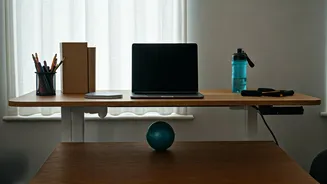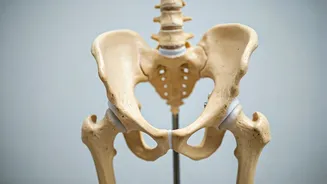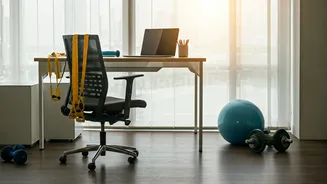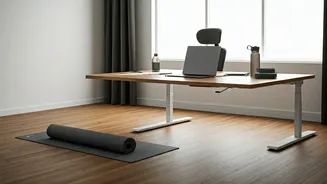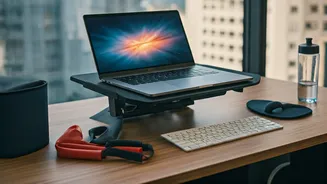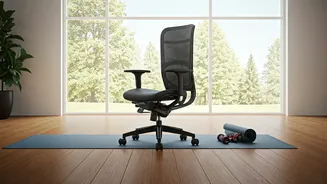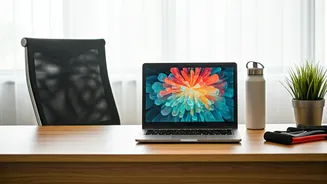Neck Rolls: Ease Tension
Neck rolls are an excellent starting point for mitigating stiffness, particularly after long periods focused on your computer screen. To do this, gently
drop your chin towards your chest. Slowly roll your right ear toward your right shoulder, hold the stretch, then bring your head back to the chest. Continue the rolling motion to the left shoulder, and return to the center. Repeating this movement a few times can significantly lessen tightness and encourage circulation to the neck muscles. Be sure to perform this movement slowly, avoiding any sudden or jerky motions that could lead to injury. Listen to your body and work only within a comfortable range of motion.
Shoulder Rolls: Unwind Stress
Shoulder rolls are a fantastic way to release the tension that often builds up in your shoulders and upper back. To do this, simply roll your shoulders forward in a circular motion, bringing them up towards your ears, then back and down. Make the movement slow and deliberate, concentrating on the muscles relaxing with each roll. Reverse the direction, and repeat the motion. The act of shoulder rolling counteracts the rounded posture often adopted while seated, and restores proper alignment. Regular shoulder rolls can lead to increased flexibility and reduced discomfort associated with prolonged sitting, contributing towards a more comfortable and healthy work environment. Aim for several repetitions throughout the day.
Wrist Stretches: Prevent Strains
The wrists are frequently engaged in repetitive movements while typing or using a mouse. This can lead to strain. Wrist stretches are crucial for preventing pain and maintaining mobility. Start by extending your arm straight in front of you, with your palm facing down. Using your other hand, gently bend your wrist towards the floor, feeling the stretch along the top of your forearm. Hold for a few seconds. Switch to bending your wrist upwards, and hold that position. Repeating these motions several times a day will help alleviate and prevent carpal tunnel symptoms, keeping your hands flexible and pain-free. It’s also important to vary your movements and take brief breaks.
Torso Twists: Boost Circulation
Torso twists are superb for boosting blood circulation and improving spinal mobility, especially important when seated for hours. Sit upright in your chair, feet flat on the floor. Place your hands on your knees or the armrests for support. Gently twist your torso to one side, holding the position for a few seconds before returning to the center. Then, repeat on the opposite side. It promotes better oxygen flow and can prevent the stiffness that accumulates in the lower back. This simple exercise not only enhances flexibility, but also aids in the digestion and energy levels. Integrate twists during the day.
Leg Extensions: Wake Up Legs
Leg extensions serve to awaken the leg muscles and combat the effects of inactivity. While seated, extend one leg straight out in front of you, keeping it elevated for a few seconds before lowering it. Repeat with the other leg. Make sure your back remains straight, and engage your core to support your posture. This easy exercise supports circulation in the legs, and reduces feelings of heaviness and fatigue. You can repeat these leg extensions multiple times throughout your workday to avoid stiffness, helping you feel more energized. It is particularly useful if your job requires a lot of sitting without much opportunity for movement.
Ankle Circles: Fight Swelling
Ankle circles assist in stimulating circulation, and helping to alleviate swelling in the lower legs and feet, an issue common during lengthy periods of sitting. While seated, lift one foot off the floor and rotate your ankle in a circular motion, clockwise and then counterclockwise. Repeat this exercise with the other foot. These simple movements stimulate blood flow, which is necessary for preventing discomfort and puffiness in your lower extremities. This will leave you feeling refreshed and much more mobile. Make sure to integrate this regularly.
Desk Push-ups: Build Strength
Desk push-ups are an accessible method for building upper body strength. Facing your desk, place your hands shoulder-width apart on the edge of the desk. Lean into the desk, bending your elbows and lowering your chest towards the edge. Then, push back up to the starting position. This motion strengthens your chest, shoulders, and triceps, while also improving your posture and counteracting the effects of hunching over a computer. If this becomes easy, gradually increase the number of repetitions. Regular desk push-ups boost your energy levels and help in a better posture. Ensure to keep your back straight throughout.





